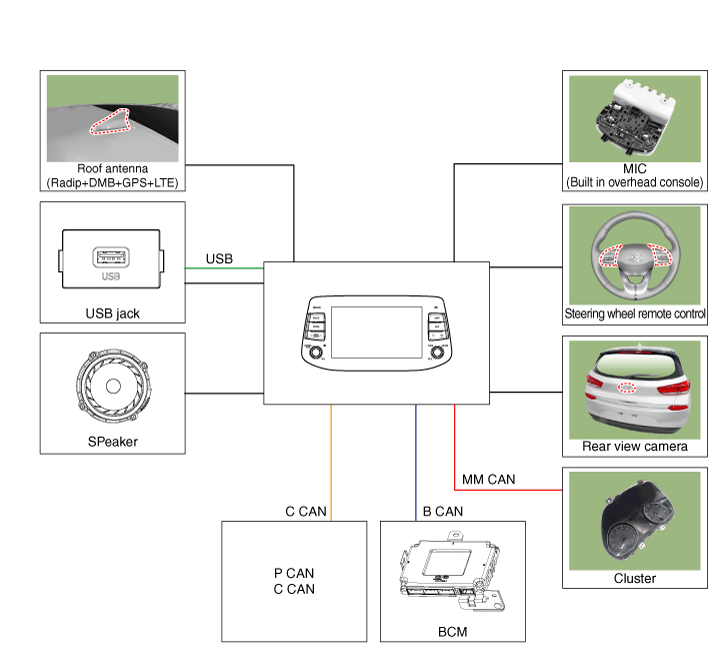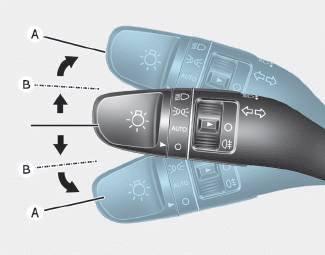Hyundai i-30: AVN System / Description and operation
AVN system
The AVN system has improved information search and easiness of manipulation
for the driver by simplifying the system operation experience and unifying the
display of the user information such as multimedia and car information.
The system is basically composed of a keyboard for the operation of combined
function, LCD monitor, a head unit with Bluetooth handsfree calling, voice recognition
and navigation, music amplifier and the media unit that connects with other
outside devices.
|
1. |
Simplification of user interface : the multimedia and car information
are displayed on the monitor.
|
|
2. |
Networked electronic parts : Efficient information transmission through
CAN communications.
|
|
3. |
Up-to-date technologies integrated :
| •
|
Voice recognition : This function recognizes the user's voice
commands to manipulate the system. The user can issue voice
commands to operate AV system, Bluetooth phone and navigation
and connect to Cubis call center.
|
| •
|
Bluetooth hands-free calling : This is compliant with the international
wireless communication standards and uses bluetooth technology
adopted in most currently launched mobile phones. Once connected,
it is automatically linked to the driver’s cell phone whenever
the driver gets in the car.
|
| •
|
USB/iPod connectivity : External music devices like iPod, USB
memory stick, Walkman are connected and played through the car
speakers. iPod can be operated using the integrated keyboard.
|
|
System Block Diagram

| • |
B-CAN : Body Controller Area Network
|
| • |
MM-CAN : Multi-Media Controller Area Network
|
Limitations Of The Navigation system
GPS Signal Reception State
As the GPS satellite frequency is received/transmitted in straight lines, reception
may not work if hiding devices are placed on or near the GPS antenna or when
traveling through the following locations.
| • |
Basement parking structures
|
| • |
Roads within forested areas
|
| • |
Areas near high rise buildings
|
Vehicle Position Display
|
1. |
If multipass errors occur due to reflections from buildings or related
causes, the current position mark on the navigation may differ from
the actual position of the vehicle.
|
|
2. |
The position of the vehicle on the navigation may be different from
the actual position if the vehicle is under the occur, driving for a
short period of time will vehicle through map matching or GPS information
(several minutes may be necessary in certain cases).
| •
|
When driving on a Y-shaped road with a narrow angle, the current
position may be displayed in the opposite direction.
|
| •
|
If the vehicle is loaded onto a car transport vehicle, the current
position mark may be stalled on the last position prior to loading.
|
| •
|
When driving on a spiral-shaped road.
|
| •
|
When driving in mountain regions with sharp turns or sudden
brakes.
|
| •
|
When entering a road after having been in an underground parking
structure, building parking structure, or turnable with many
rotations.
|
| •
|
When the tires have recently been replaced (Especially upon
use of spare or studless tires)
|
| •
|
If the battery terminal is removed.
|
| •
|
When driving in city streets, the current position may be displayed
on the opposite side or on an off-road position.
|
| •
|
When changing the zoom level from the maximum zoom in level
to a different zoom level, the current position mark may be
displayed on a different road.
|
| •
|
When driving in heavy traffic with frequent go · stops in traffic
or intersections.
|
| •
|
When driving under slippery conditions, such as heavy sand,
snow, etc.
|
| •
|
When driving with the tire chain in place.
|
| •
|
When using a tire with an incorrect size specification.
|
| •
|
When the tire pressure for the 4 tires are different.
|
| •
|
When the replacement tire is a worn or used tire (Especially
studless tires having passed a 2nd seasons, etc.)
|
| •
|
When driving near high-rise buildings
|
| •
|
If a roof carrier has been installed
|
| •
|
When driving under high speeds or having calculated a long-distance
route.
|
|
Route Guidance
Suitable route guidance may not occur caused by search conditions or the driving
position.
| • |
Guidance to go straight may be given while driving on a straight road.
|
| • |
Guidance may not be given even when having turned at an intersection.
|
| • |
There are certain intersections in which guidance may not occur.
|
| • |
A route guidance signaling entrance into a no enter zone may occur (No
enter zone, road under construction, etc.)
|
| • |
Guidance may be given to a position removed from the actual destination
if roads to reach the actual destination do not exist or are too narrow.
|
| • |
Faulty voice guidance may be given if the vehicle breaks from the designated
route (ex : if a turn is made at an intersection while the navigation
provided guidance to go straight).
|
| • |
Map Data may be missing or incorrect causing route guidance to not be
given.
|
Route Re-calculation
The following phenomena may occur after conducting route recalculation.
| • |
When turning at an intersection, the navigation system gives wrong information
on the current position.
|
| • |
Route recalculation may take a longer period of time when driving under
high speeds.
|
| • |
A route guidance signaling for a U-Turn in a No U-Turn location may
occur.
|
| • |
A route guidance signaling entrance into a no enter zone may occur (No
enter zone, road under construction, etc).
|
| • |
Guidance may be given to a position removed from the actual destination
do not exist or are too narrow.
|
| • |
Faulty voice guidance may be given if the vehicle breaks from the designated
route (ex : if a turn is made at an intersection while the navigation
provided guidance to go straight)
|
Component Location
1. AVN4.0 head
unit (8inch)
2. Roof antenna
3. Multimedia jack
5. Steering wheel
remote control
6...
Components and components location
Components
[AVN Head Unit]
Connector Pin Information
No
Connector A
Connector B
Connector C
1
Rear door speaker (Left +)
-
B-CAN (High)
2
Rear door speaker (Left -)
Mic_Signal (+)
C-CAN (High)
3
-
-
-
4
-
-
-
5
-
-
-
6
Camera power
Illumination (+)
-
7
Camera video
MM CAN (High)
-
8
-
-
B-CAN (Low)
9
-
-
C-CAN (Low)
10
-
Battery (+)
-
11
DTC
Battery (+)
-
12
Steering wheel remote
Ground
-
13
Front door speaker (Left +)
Ground
-
14
Front door speaker (Left -)
-
-
15
Front door speaker (Right -)
Mic_Signal (-)
-
16
Front door speaker (Right +)
-
-
17
-
-
-
18
-
-
-
19
-
Illumination (-)
-
20
Camera power ground
MM CAN (Low)
-
21
Camera video ground
-
-
22
-
ACC
23
-
-
24
-
-
25
-
-
26
Steering wheel remote grond
-
27
Rear door speaker (Right -)
-
28
Rear door speaker (Right +)
-
29
-
-
30
-
-
31
-
-
32
-
IGN 1
33
Camera shield ground
-
34
-
-
35
-
-
36
-
37
-
38
Vehicle speed
Repair procedures
Removal
•
Take care not to scratch the cluster fascia panel and related
parts...
Other information:
WARNING
Whenever leaving the vehicle or
parking, always come to a complete
stop and continue to
depress the brake pedal. Move
the shift lever into the P (Park)
position, then apply the parking
brake, and place the ignition
switch in the LOCK/OFF position...
DAW (Driver Attention Warning)
system
When the "Check DAW (Driver
Attention Warning) system" warning
message appears, the system is not
working properly. In this case, we recommend
that you have the vehicle
inspected by a HYUNDAI authorised
repairer...
Categories

To signal a turn, push down on the
lever for a left turn or up for a right
turn in position (A). To signal a lane
change, move the turn signal lever
slightly and hold it in position (B).The
lever will return to the OFF position
when released or when the turn is
completed.
read more

 Components and components location
Components and components location AVN(Audio Video Navigation) head unit
AVN(Audio Video Navigation) head unit
